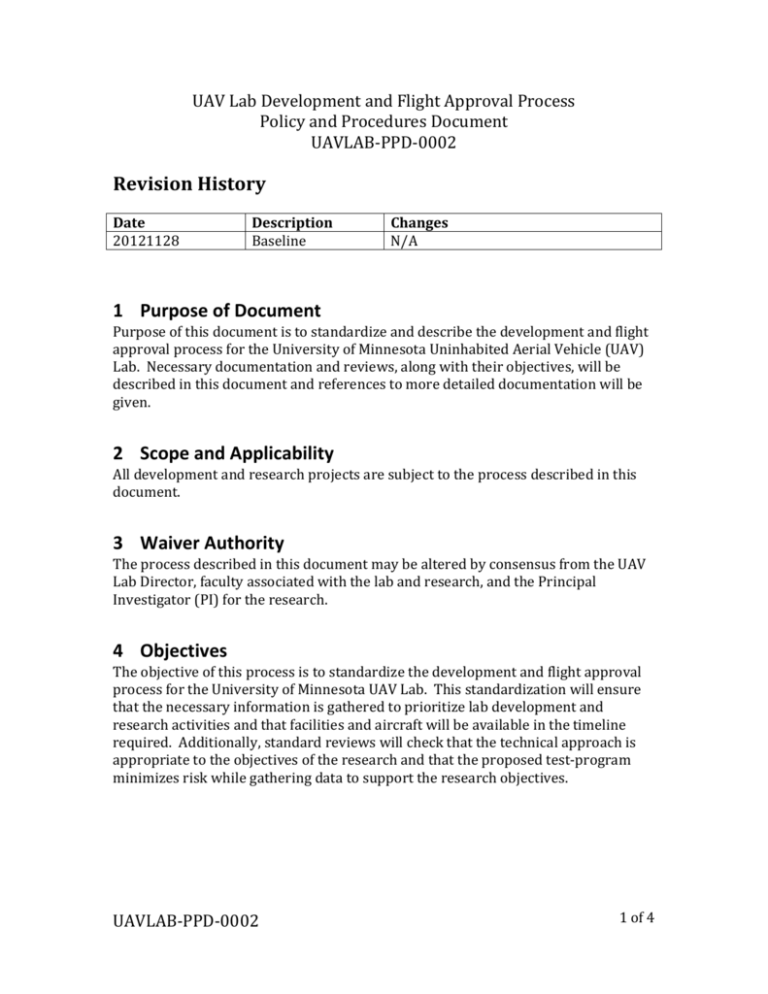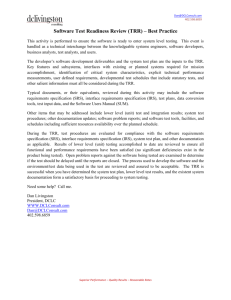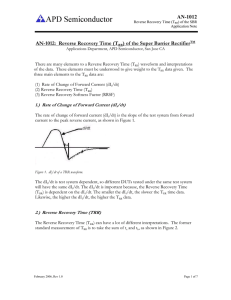UAV Lab Development and Flight Approval UAVLAB-PPD
advertisement

UAV Lab Development and Flight Approval Process Policy and Procedures Document UAVLAB-PPD-0002 Revision History Date 20121128 Description Baseline Changes N/A 1 Purpose of Document Purpose of this document is to standardize and describe the development and flight approval process for the University of Minnesota Uninhabited Aerial Vehicle (UAV) Lab. Necessary documentation and reviews, along with their objectives, will be described in this document and references to more detailed documentation will be given. 2 Scope and Applicability All development and research projects are subject to the process described in this document. 3 Waiver Authority The process described in this document may be altered by consensus from the UAV Lab Director, faculty associated with the lab and research, and the Principal Investigator (PI) for the research. 4 Objectives The objective of this process is to standardize the development and flight approval process for the University of Minnesota UAV Lab. This standardization will ensure that the necessary information is gathered to prioritize lab development and research activities and that facilities and aircraft will be available in the timeline required. Additionally, standard reviews will check that the technical approach is appropriate to the objectives of the research and that the proposed test-program minimizes risk while gathering data to support the research objectives. UAVLAB-PPD-0002 1 of 4 5 Description of Policy or Procedure Below, a flowchart depicts the overall development and flight approval process. The following descriptions describe each step of the process in further detail. Following initial conceptual development and feasibility studies, an Objectives and Requirements Document (ORD) is written. The purpose of the ORD is to document: 1. Objectives 2. Requirements 3. Technical approach 4. Facilities or test platforms required 5. Schedule 6. Work Breakdown Structure (WBS) 7. Documentation/Publication Plan At a high level, the ORD describes the objectives of the development or research activity, the technical approach to meeting those objectives, the facilities and platforms required, and gives insight into the scheduling and work breakdown of lab resources, facilities, and platforms. This information is necessary for prioritizing lab development and research activities and ensuring that key personnel, facilities, and platforms will be available to support the proposed development and research. Finally, a description of how the development or research activities will be documented or published is given. Typically, the ORD is prepared by the development or research activity PI and is sent for approval to the UAV Lab Director and faculty associated with the lab and research. Approvers may designate additional people required to review the ORD and may require a presentation (peer review) in addition to the document. A minimum of 7 days must be given for review and approval. UAVLAB-PPD-0002 2 of 4 Following approval of the ORD, and potentially a peer review, full-scale development and research activities may commence. Once the development or research is ready for a hardware test or flight-test, a Test Readiness Review (TRR) is required before the test can proceed. Like the ORD, the TRR is a document, and potentially a presentation. The objectives of the TRR are to describe and document: 1. Scope of the hardware or flight tests that the PI is seeking approval for, addendums may be written to extend the scope 2. Objectives of the tests 3. Changes from the ORD or Peer Review 4. Test or flight plan 5. Deviations from the Standard Operating Procedures (SOPs) 6. Deviations from the Safety of Flight or Safety of Test (SOF/SOT) limits 7. Test specific procedures not covered in the SOPs (test cards/flight cards) 8. Test specific limits not covered in the SOF/SOT limits 9. Roles and responsibilities of test personnel not covered in the SOPs 10. Risk and hazard analysis for the test 11. Required briefings before and after the test (T-1, T-0, Post test/flight debriefing) The TRR is meant to give an opportunity to review the planned test, ensure that the planned test will meet the objectives, and review the safety of the test. Standard Operating Procedures and Safety of Flight/Safety of Test (SOF/SOT) are located in hardware and aircraft specific manuals. These manuals should be consulted and standard procedures/limits altered as necessary with justification given in the TRR. Typically, the TRR is prepared by the development or research activity PI and is sent for approval to the UAV Lab Director and faculty associated with the lab and research. Approvers may designate additional people required to review the TRR and may require a presentation in addition to the document. A minimum of 5 days must be given for review and approval. Following approval a minimum of 3 days must be given prior to commencing the hardware or flight test, unless specifically waived in the TRR process. The 3 day waiting period is to allow approvers time in case there are doubts or second-thoughts about the test. An addendum to the original TRR may be written to extend the scope of the approved testing. A minimum of 2 days must be given for review and approval. Testing may commence immediately upon approval. An addendum is also required if an unexpected event occurs which posses a risk to the safety of the platform or personnel involved with the test. UAVLAB-PPD-0002 3 of 4 6 Relevant Documents Detailed documentation for each document and review is available separately: Objectives and Requirements Document Template, UAVLAB-PPD-0003 Test Readiness Review Template, UAVLAB-PPD-0004 Standard Operating Procedures (SOPs) and Safety of Flight/Safety of Test (SOF/SOT) limits are given in hardware or aircraft specific manuals: Aircraft Platforms Ultra Stick 120, UAVLAB-MAN-0001 Ultra Stick 25e, UAVLAB-MAN-0002 Body-Freedom-Flutter (BFF), UAVLAB-MAN-0003 Hardware Test Equipment Moment of Inertia Apparatus Wind Tunnel UAVLAB-PPD-0002 4 of 4







